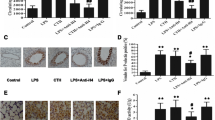Abstract
Hyperoxia stimulates alveolar macrophages (AM) to make and release a factor which increases neutrophil adherence to nylon fiber. Production of the neutrophil adherence-stimulating factor by AM exposed to hyperoxia is maximal after AM have been exposed to hyperoxia for 72 h and requires protein synthesis by intact AM. The adherence factor is heat-labile and by column chromatography elutes in a molecular-weight range of approximately 8000–18,000 daltons. The AM-derived adherence factor could influence accumulation of neutrophils in the lungs of animals exposed to hyperoxia and contribute to neutrophil-mediated lung injury from hyperoxia.
Similar content being viewed by others
References
Crapo, J. D., B. E. Barry, H. A. Foscue, andJ. Shelburne. 1980. Structural and biochemical changes in rat lungs occurring during exposures to lethal and adaptive doses of oxygen.Am. Rev. Respir. Dis. 122:123.
Shasby, D. M., R. B. Fox, R. N. Harada, andJ. E. Repine. 1982. Reduction of the edema of acute hyperoxic lung injury by granulocyte depletion.J. Appl. Physiol.52:1237.
Shasby, D. M., S. S. Shasby, andM. J. Peach. 1983. Granulocytes and phorbol myristate acetate increase permeability to albumin of cultured endothelial monolayers and isolated perfused lungs.Am. Rev. Respir. Dis. 127:72.
Shasby, D. M., K. M. VanBenthuysen, R. M. Tate, S. S. Shasby, I. F. McMurtry, andJ. E. Repine. 1982. Granulocytes mediate acute edematous lung injury in rabbits and isolated rabbit lungs perfused with phorbol myristate acetate: Role of oxygen radicals.Am. Rev. Respir. Dis. 125:443.
Kazmierowski, J. A., J. I. Gallin, andH. Y. Reynolds. 1977. Mechanism for the inflammatory response in primate lungs: Demonstration and partial characterization of an alveolar macrophage derived chemotactic factor with preferential activity for polymorphonuclear leukocytes.J. Clin. Invest. 59:273.
Hunninghake, G. W., J. I. Gallin, andA. S. Fauci. 1978. Immunologic reactivity of the lung: The in vivo and in vitro generaton of a neutrophil chemotactic factor by alveolar macrophages.Am. Rev. Respir. Dis. 117:15.
Merrill, W. W., G. P. Naegel, R. A. Matthay, andH. Y. Reynolds. 1980. Alveolar macrophage-derived chemotactic factor: Kinetics of in vitro production and partial characterization.J. Clin. Invest. 65:268.
Fox, R. B., J. R. Hoidal, D. M. Brown, andJ. E. Repine. 1981. Pulmonary inflammation due to oxygen toxicity: Involvement of chemotactic factors and polymorphonuclear leukocytes.Am. Rev. Respir. Dis. 123:521.
Harada, R. N., C. M. Bowman, R. B. Fox, andJ. E. Repine. 1982. Alveolar macrophage secretions: Initiators of inflammation in pulmonary oxygen toxicity?Chest 81:52.
Hoidal, J. R., G. D. Beall, F. L. Rasp, B. Holmes, J. G. White, andJ. E. Repine. 1978. Comparison of the metabolism of alveolar macrophages from humans, rats and rabbits: Response to heat-killed bacteria or phorbol myristate acetate.J. Lab. Clin. Med. 92:787.
Repine, J. E., J. G. White, C. C. Clawson, andB. M. Holmes. 1974. The effect of phorbol myristate acetate on the metabolism and ultrastructure of neutrophils in chronic granulomatous disease.J. Clin. Invest. 54:83.
MacGregor, R. R., P. J. Spagnulo, andA. L. Lentnek. 1974. Inhibition of granulocyte adherence by ethanol, prednisolone, and aspirin, measured with an assay system.N. Engl. J. Med. 291:642.
Rasp, F. L., C. C. Clawson, J. R. Hoidal, andJ. E. Repine. 1979. Quantitation and scanning electron microscopic comparison of human alveolar macrophage and polymorphonuclear leukocyte adherence to nylon fibers in vitro.J. Reticuloendothel. Soc. 25:101.
Repine, J. E., andC. C. Clawson. 1978. Influence of surface proteins and separation techniques on neutrophil unstimulated and stimulated locomotion in vitro.J. Reticuloendothel. Soc. 24:217.
Hoidal, J. R., R. B. Fox, andJ. E. Repine. 1979. Defective oxidative metabolic responses in vitro of alveolar macrophages in chronic granulomatous disease.Am. Rev. Respir. Dis. 120:613.
Nathan, C. F., H. W. Murray, andZ. A. Cohn. 1980. Current concepts: The macrophages as an effector cell.N. Engl. J. Med. 303:622.
Boxer, L. A., M. Yoder, S. Bonsib, M. Schmidt, P. Ho, R. Jersilo, andR. L. Baehner. 1979. Effects of a chemotactic factor, N-formyl methionyl peptide, on adherence, superoxide anion generation, phagocytosis, and microtubule assembly of human polymorphonuclear leukocytes.J. Lab. Clin. Med. 93:506.
O'Flaherty, J. T., D. L. Kreutzer, andP. A. Ward. 1978. Chemotactic factor influences on the aggregation, swelling, and foreign surface adhesiveness of human leukocytes.Am. J. Pathol. 90:537.
Repine, J. E., C. M. Bowman, andR. M. Tate. 1982. Neutrophils and the lung. State of the art.Chest 81:47.
Author information
Authors and Affiliations
Additional information
This work was supported by grants from the Americans Heart Association, National Institutes of Health HL24248, Council for Tobacco Research, and the Kroc. hill, Swan, Kleberg and Parker B. Francis Foundation.
Rights and permissions
About this article
Cite this article
Bowman, C.M., Harada, R.N. & Repine, J.E. Hyperoxia stimulates alveolar macrophages to produce and release a factor which increases neutrophil adherence. Inflammation 7, 331–338 (1983). https://doi.org/10.1007/BF00916297
Issue Date:
DOI: https://doi.org/10.1007/BF00916297




